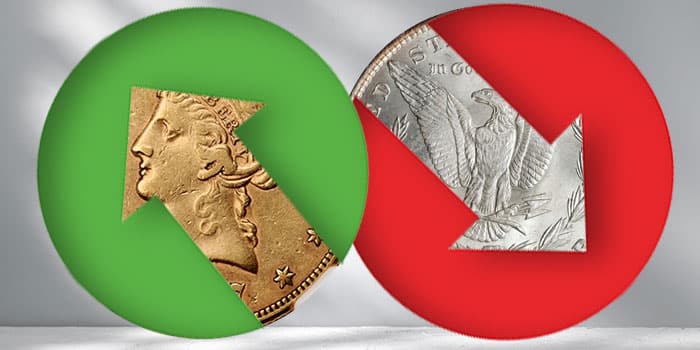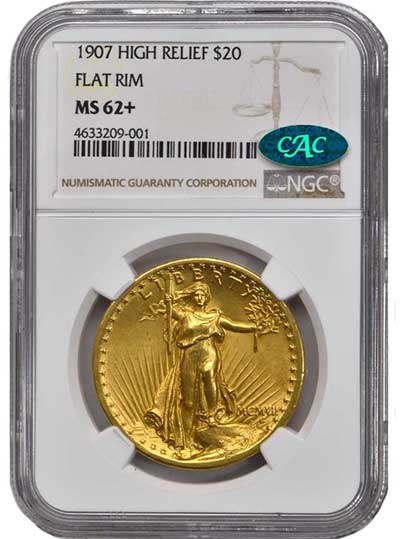Whenever someone sits down with a financial consultant to make determinations for investing, one of the first questions that might be asked is: “What is your tolerance for risk?” This question is crucial for several reasons and can be applied to your numismatic purchases.
The fact is, most people are very conservative when it comes to investing. The financial consultant will gauge your ability to handle risk and make investment suggestions based on your answers. All investors hate to lose money. It has been said that the joy of potential profits is far outweighed by the fear of losing money by most people. That is why investors generally choose mixed investments that will spread risk and avoid a sharp decline in portfolio balances.
During the height of the 2008-2009 financial crisis, there was virtually nowhere to hide for investors. Most sustained heavy losses and could not stand the thought of opening their monthly statements. This was actually a good idea for many because if they had studied the results of their investments, then they might have panicked and sold at the bottom. The recent correction in the stock market has many feeling the same way.
For rare coin buyers, assessing risk is sometimes an underrated exercise. As with any investment, coin collectors should weigh the upside and the downside of any purchase. Whenever I purchase a coin for inventory, I carefully decide the possible profit for that coin. The potential profit is important. But equally important is the possible downside of that purchase.
Most professional rare coin dealers buy thousands of coins each year. In the long run, we make money on the majority of the coins; nevertheless, losses are an inevitable part of the business. When offered an expensive coin, I run through the math to determine if the coin represents a sound purchase.
For example, let’s say the seller is asking $10,000 for a certain coin. I will check current price guides, population information, and recent auction records. Hopefully, I will also have handled an example of the issue at one time or another. After a close study, I might determine that in the worst case, the coin would bring $9,500, and if things work out, the coin could sell for $12,000. The potential $2,000 profit outweighs the possible $500 loss.
In other words, I have a risk tolerance of $500 for this possible purchase. Some rare coin buyers can’t stand to lose money on a coin and would rather pass on the opportunity of making the $2,000 profit. Much of this also has to do with confidence in one’s ability to determine the risk. I believe that is the key ingredient for any successful rare coin dealer or collector.

With the stock market retreating so much in the last month or two, many are concerned that the “negative wealth effect” will eventually impact rare coin prices. Now might be a good time to consider your tolerance for risk when buying coins. The market for top-end coins has been shockingly strong in the last few years. A pullback for some areas of the market would be understandable.
As I have stated many times in these articles, knowledge is the most useful tool when making a buying decision. That is why many collectors do much better when they pick a series and focus their energy on understanding the factors that determine the value of the coins they collect. With the proper knowledge, you can have an understanding of the risks involved in rare coin purchases.
If you have a low tolerance for risk (as many do), then you should make your purchases based on facts that you fully understand. Occasionally, collectors will have to get out of their comfort zone when something comes up that is rarely offered. When I have the chance to purchase a rare coin that rarely comes to market, I am willing to handle more risk. I know that someone else will probably appreciate this rare opportunity and offer me a profit. Collectors are in a similar situation.
 If you can buy a great coin, you can almost be certain that another collector in the future will also want that great coin. The key words being in the future. Never stretch to buy a great coin that you might need to sell relatively soon. You might not quickly find someone who is willing to stretch as you have, and you could be faced with a substantial loss. This comes back to your risk tolerance.
If you can buy a great coin, you can almost be certain that another collector in the future will also want that great coin. The key words being in the future. Never stretch to buy a great coin that you might need to sell relatively soon. You might not quickly find someone who is willing to stretch as you have, and you could be faced with a substantial loss. This comes back to your risk tolerance.
In general, collectors should make an effort to assess their tolerance for risk when making an investment in rare coins. As with other investments, your timeline for investing is also extremely important. A stock advisor will ask if you are investing money that you might need sometime soon. Obviously, if you might need the funds in the near future, you should avoid risky investments that might drop sharply and will take years to recover. Investing in coins should also be for collectors who think long term.
For collectors buying over a period of years, price drops can be an advantageous time to make purchases. This sort of cost averaging generally works out in the long term. Many of the greatest collections took decades to assemble, and the resulting returns for each were spectacular.
Collecting rare coins can be a passion, but nearly every buyer is concerned with the financial results of their pursuit. As with your other investments, consider all factors when making a purchase decision. Your long-term results will hopefully bring you years of enjoyable collecting that also turns into a great investment!
